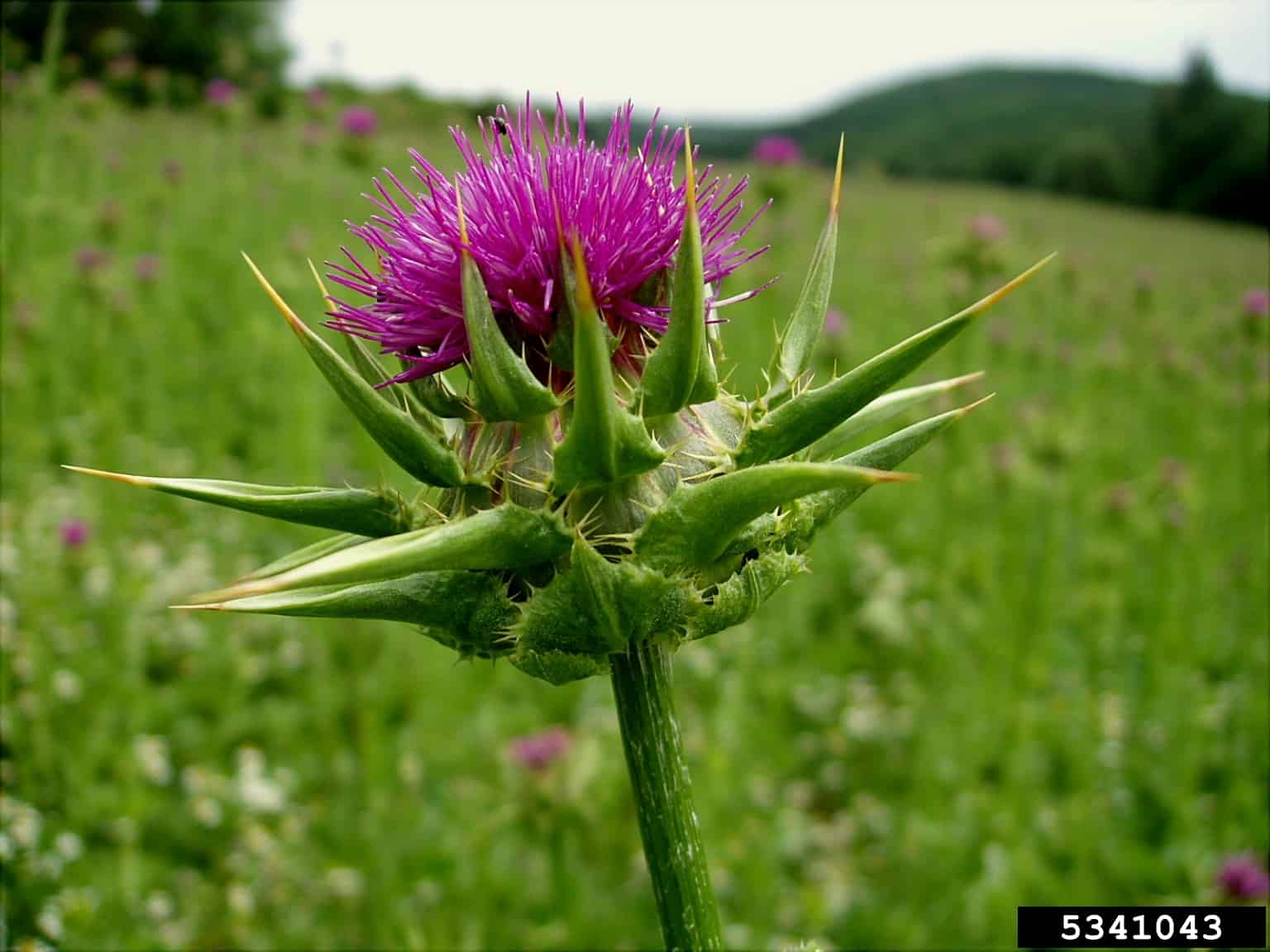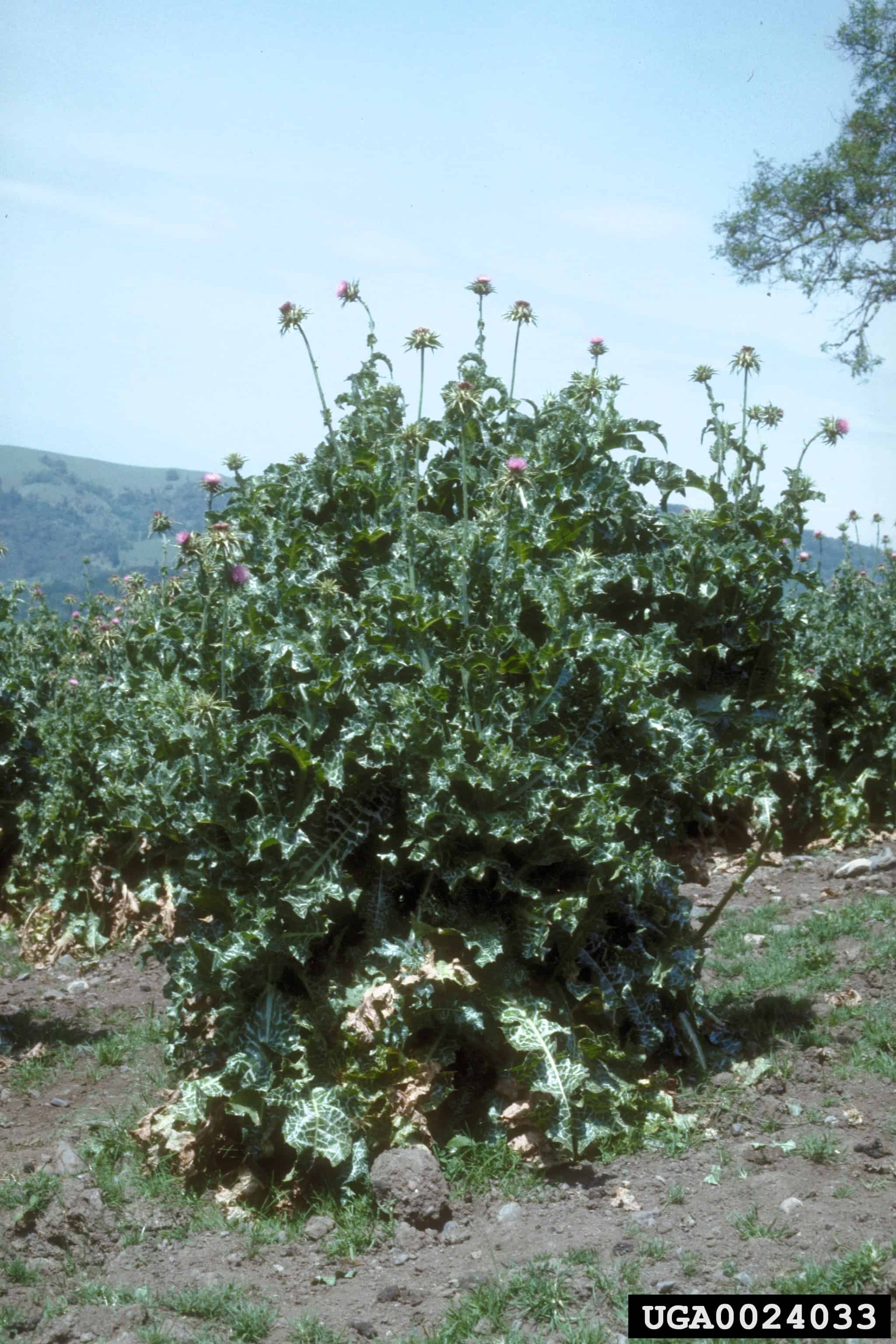Silybum marianum
Explore More :
Explore plus :
Overview
Aperçu
Regulation :
Remarques Réglementation:
- Quarantine lists of countries e.g. Mexico *may be updated without notice
Regulation Notes:
On quarantine lists of countries e.g. Mexico*.
*Quarantine lists of countries may be updated without notice.
Distribution :
Répartition :
This species is native to northern Africa, temperate and tropical Asia and southern Europe, introduced to other regions in Africa and Europe as well as Australia, New Zealand, North and South America (USDA-ARS 2017). In the United States, it occurs in western, southern and eastern states (USDA-NRCS 2017).
Habitat and Crop Association :
Habitat et Cultures Associées :
Milk thistle occurs in hedgerows, old fields, roadsides and disturbed areas (Darbyshire 2003).
Economic Use, cultivation area, and Weed Association :
Utilisation économique, zone de culture et association de mauvaises herbes :
Duration of Life Cycle :
Durée du cycle vital:
Annual or biennial
Dispersal Unit Type :
Type d’unité de dispersion :
Achene
General Information
RENSEIGNEMENTS GÉNÉRAUX
This species prefers nutrient rich soils, especially those high in nitrogen. Cultivated as a medicinal seed crop, it has often escaped and become a weed problem. Achenes are spread naturally by wind and water and the oily style appendage may aid in ant dispersal. Accidental dispersal of achenes also occurs from contaminated hay, vehicles and farm machinery (CABI 2017).
.
Silybum marianum infestation (Jan Samanek, Phytosanitary Administration, Bugwood.org)
Identification
Identification
-
Achene
Size
- Achene length: 5.6 – 6.9 mm (average: 6.4 mm); width: 2.1 – 3.3 mm (average: 2.8 mm)
Shape
- Achene is oblong with one truncate and one rounded end, slightly curved and compressed
Surface Texture
- Achene surface appears smooth, but shallow wrinkles can be seen under magnification
Colour
- Achene is slightly shiny, dark brown or black with small yellow streaks; the collar is light yellow
- Immature and some mature achenes have pale patches on the surface
Other Features
- A thick, lobed style appendage is on the truncate end, surrounded by a thin collar
- The rounded end of achene has a small notch
- A long white pappus may be present on immature or freshly harvested mature achenes

Milk thistle (Silybum marianum) achenes




Identification Tips
CONSEILS POUR L’IDENTIFICATION
Additional Botany Information
AUTRES RENSEIGNEMENTS BOTANIQUES

Silybum marianum flower (Jan Samanek, Phytosanitary Administration, Bugwood.org)





Similar Species
ESPÈCES SEMBLABLES
Similar species are based on a study of seed morphology of various species, and those with similar dispersal units are identified. The study is limited by physical specimen and literature availability at the time of examination, and possibly impacted by the subjectivity of the authors based on their knowledge and experience. Providing similar species information for seed identification is to make users aware of similarities that could possibly result in misidentification.
Carduus nutans (nodding thistle)
Nodding thistle achenes are a similar curved, elongate shape, with a smooth surface texture and a large style appendage as milk thistle.
Nodding thistle achenes are generally smaller (average length: 3.1 mm; average width: 1.3 mm), the style appendage is not lobed; the surface is a lighter colour without streaks and is glossy compared to milk thistle.
Click to select species
Cliquez pour sélectionner les espèces

Carduus nutans
Comparison Window
Fenêtre de comparaison
MAIN SPECIES
ESPÈCES PRINCIPALES
Silybum marianum

Silybum marianum
Asteraceae
Milk thistle (Silybum marianum) achenes
MAIN SPECIES
ESPÈCES PRINCIPALES
Silybum marianum

Silybum marianum
Asteraceae
Milk thistle (Silybum marianum) achenes
MAIN SPECIES
ESPÈCES PRINCIPALES
Silybum marianum

Silybum marianum
Asteraceae
Milk thistle (Silybum marianum) achene
MAIN SPECIES
ESPÈCES PRINCIPALES
Silybum marianum

Silybum marianum
Asteraceae
Milk thistle (Silybum marianum) achene
SIMILAR SPECIES
ESPÈCES SEMBLABLES
Carduus nutans

Carduus nutans
Asteraceae
Nodding thistle (Carduus nutans) achenes
SIMILAR SPECIES
ESPÈCES SEMBLABLES
Carduus nutans

Carduus nutans
Asteraceae
Nodding thistle (Carduus nutans) achenes
SIMILAR SPECIES
ESPÈCES SEMBLABLES
Carduus nutans

Carduus nutans
Asteraceae
Nodding thistle (Carduus nutans) achene
SIMILAR SPECIES
ESPÈCES SEMBLABLES
Carduus nutans

Carduus nutans
Asteraceae
Nodding thistle (Carduus nutans) achene
SIMILAR SPECIES
ESPÈCES SEMBLABLES
Carduus nutans

Carduus nutans
Asteraceae
Nodding thistle (Carduus nutans) top of achene
SIMILAR SPECIES
ESPÈCES SEMBLABLES
Carduus nutans

Carduus nutans
Asteraceae
Nodding thistle (Carduus nutans) bottom of achene
Need ID Help?
Besoin d’aide pour l’identification?
Reference(s)
Référence(s)
Centre for Agriculture and Bioscience International (CABI). 2017. Invasive Species Compendium, CAB International, Wallingford, UK. https://www.cabidigitallibrary.org/journal/cabicompendium Accessed April 25, 2017.
Darbyshire, S. J. 2003. Inventory of Canadian Agricultural Weeds. Agriculture and Agri-Food Canada, Research Branch. Ottawa, ON.
Flora of North America (FNA) Editorial Committee, eds. 1993+. Flora of North America North of Mexico [Online]. 22+ vols. New York and Oxford. Accessed December 29, 2022.
Global Biodiversity Information Facility (GBIF) Secretariat. 2022. https://doi.org/10.15468/39omei Accessed via https://www.gbif.org/species/3145214 Accessed December 29, 2022.
U.S. Department of Agriculture-Agricultural Research Services (USDA-ARS). 2017. Germplasm Resources Information Network (GRIN), https://npgsweb.ars-grin.gov/gringlobal/taxon/taxonomysearch Accessed April 25, 2017.
U.S. Department of Agriculture-Natural Resources Conservation Service (USDA-NRCS). 2017. The PLANTS Database. National Plant Data Team, Greensboro, NC USA. https://plants.usda.gov/home Accessed April 25, 2017.




